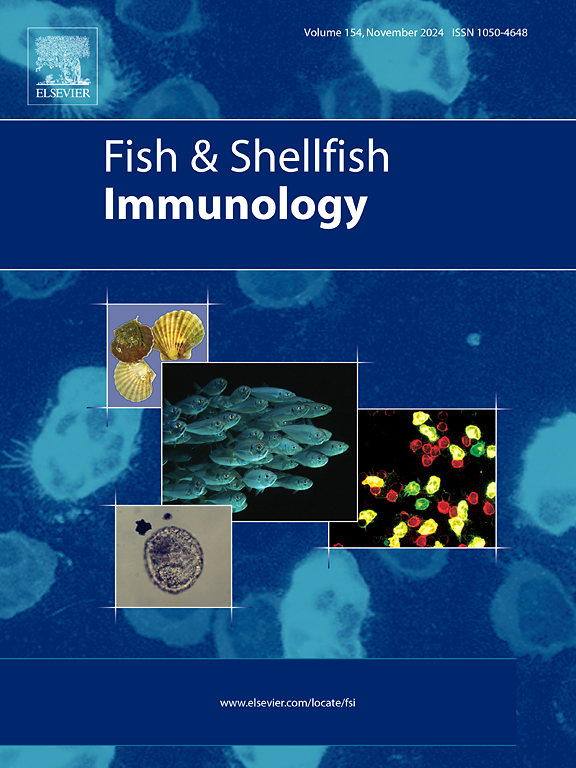Insights into the functional properties of thioredoxin domain-containing protein 12 (TXNDC12): Antioxidant activity, immunological expression, and wound-healing effect in yellowtail clownfish (Amphiprion clarkii)
IF 4.1
2区 农林科学
Q1 FISHERIES
引用次数: 0
Abstract
Thioredoxin domain-containing protein 12 (TXNDC12) is a member of the thioredoxin-like superfamily that contributes to various thiol-dependent metabolic activities in all living organisms. In this research, the TXNDC12 gene from yellowtail clownfish (Amphiprion clarkii) was structurally characterized using in silico tools, assessed for immunological expression, and evaluated for biological activity using recombinant protein and cellular overexpression. The deduced coding sequence of AcTXNDC12 comprised a 522-bp nucleotide, encoding 173 amino acids with a predicted molecular mass of 19.198 kDa. The AcTXNDC12 protein consists of a66WCGAC70 active motif and a170GDEL173 signature. The highest tissue-specific expression of AcTXNDC12 was observed in the brain tissue, with significant modulation observed in the blood and gill tissues following stimulation of polyinosinic: polycytidylic acid, lipopolysaccharides (LPS), and Vibrio harveyi. In functional assays, recombinant AcTXNDC12 protein (rAcTXNDC12) showed insulin disulfide reduction activity, 2,2′-azino-di-(3-ethylbenzthiazoline sulfonic acid) decolorization antioxidant capacity, and ferric (Fe3+) reducing antioxidant potential. Additionally, a significant reduction in nitric oxide production was observed in AcTXNDC12-overexpressed RAW 264.7 cells upon LPS stimulation. Furthermore, genes associated with the regulation of oxidative stress, including nuclear factor erythroid 2-related factor 2 (Nrf2), catalase (Cat), peroxiredoxin 1 (Prx1), and ribonucleotide reductase catalytic subunit M1 (Rrm1) were significantly upregulated in fathead minnow cells overexpressing AcTXNDC12 in response to H2O2 treatment. The scratch wound healing assay demonstrated tissue regeneration and cell proliferation ability upon AcTXNDC12 overexpression. Altogether, the current study elucidated the antioxidant activity, immunological importance, and wound-healing effect of the AcTXNDC12 gene in yellowtail clownfish, providing valuable insights for advancing the aquaculture of A. clarkii fish.
对含硫氧还蛋白结构域蛋白 12(TXNDC12)功能特性的认识:黄尾小丑鱼(Amphiprion clarkii)的抗氧化活性、免疫学表达和伤口愈合效果。
含硫氧还蛋白结构域蛋白 12(TXNDC12)是硫氧还蛋白样超家族的成员,在所有生物体内参与各种硫醇依赖性代谢活动。本研究利用硅学工具对黄尾小丑鱼(Amphiprion clarkii)的 TXNDC12 基因进行了结构表征、免疫表达评估,并利用重组蛋白和细胞过表达评估了其生物活性。推导出的 AcTXNDC12 编码序列由 522-bp 核苷酸组成,编码 173 个氨基酸,预测分子量为 19.198 kDa。AcTXNDC12 蛋白由 66WCGAC70 活性基序和 170GDEL173 标识组成。在脑组织中观察到 AcTXNDC12 的最高组织特异性表达,在血液和鳃组织中观察到其在聚胞苷酸、脂多糖(LPS)和 Harveyi 弧菌刺激下的显著调节。在功能测试中,重组 AcTXNDC12 蛋白(rAcTXNDC12)显示出胰岛素二硫化物还原活性、2,2'-叠氮-二(3-乙基苯并噻唑啉磺酸)脱色抗氧化能力和铁(Fe3+)还原抗氧化潜力。此外,在 LPS 刺激下,在 AcTXNDC12 表达的 RAW 264.7 细胞中观察到一氧化氮的产生明显减少。此外,在过表达 AcTXNDC12 的黑头鲦鱼细胞中,与氧化应激调控相关的基因,包括核因子红细胞 2 相关因子 2(Nrf2)、过氧化氢酶(Cat)、过氧化还原酶 1(Prx1)和核糖核苷酸还原酶催化亚基 M1(Rrm1)在 H2O2 处理后显著上调。划痕伤口愈合试验表明,过表达 AcTXNDC12 可促进组织再生和细胞增殖。总之,本研究阐明了 AcTXNDC12 基因在黄尾小丑鱼中的抗氧化活性、免疫学重要性和伤口愈合效应,为促进黄尾小丑鱼的养殖提供了有价值的见解。
本文章由计算机程序翻译,如有差异,请以英文原文为准。
求助全文
约1分钟内获得全文
求助全文
来源期刊

Fish & shellfish immunology
农林科学-海洋与淡水生物学
CiteScore
7.50
自引率
19.10%
发文量
750
审稿时长
68 days
期刊介绍:
Fish and Shellfish Immunology rapidly publishes high-quality, peer-refereed contributions in the expanding fields of fish and shellfish immunology. It presents studies on the basic mechanisms of both the specific and non-specific defense systems, the cells, tissues, and humoral factors involved, their dependence on environmental and intrinsic factors, response to pathogens, response to vaccination, and applied studies on the development of specific vaccines for use in the aquaculture industry.
 求助内容:
求助内容: 应助结果提醒方式:
应助结果提醒方式:


